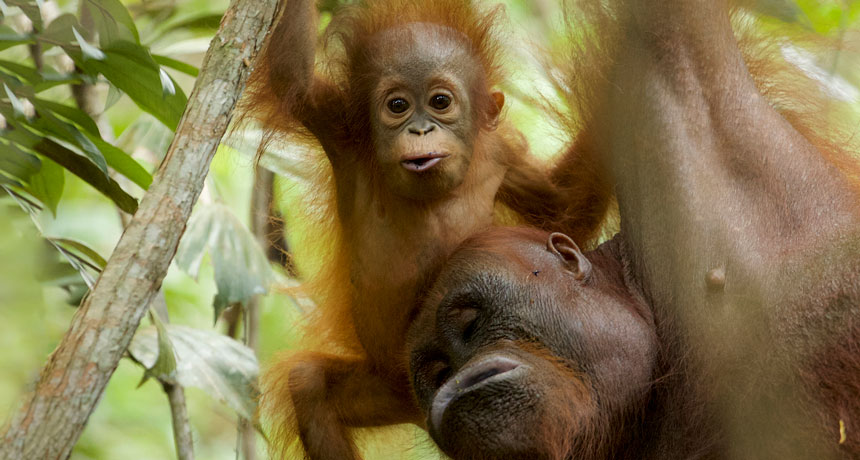Orangs nurse young for more than eight years!
With nursing tricky to watch in the wild, researchers do lab tests on teeth

This baby orangutan may end up guzzling its mom’s milk for more than eight years. Their species is a record setter among wild mammals for how long they’ll depend on mother’s milk.
Tim Laman
By Susan Milius
The supermoms of the mammal world are big, shy redheads. These orangutans are great apes. They also are great at feeding and caring for their young. To learn this, scientists didn’t just watch how long young animals spent with mom. Some also studied growth layers in their teeth. These showed youngsters can rely on mothers’ milk for eight years or more. That’s a record for wild mammals.
The teeth came from a museum specimen of a young orangutan (Pongo pygmaeus) captured in Borneo. These teeth showed no sign that the animal had been weaned — switched from mother’s milk to solid food — until it was 8.1 years old. Teeth from another orangutan (P. abelii) from Sumatra may have nursed even longer. Its teeth showed signs the animal was still nursing during the few months before it was killed at 8.8 years old.
Researchers reported these lengthy mothering behaviors May 17 in Science Advances.
Their tests also showed that youngsters don’t just stop depending on mom all at once. At times they taper off drinking their mother’s milk as they begin eating solid food. Then, if that other food gets scarce, they may return to what looks like an all-mom diet.
Such on-again, off-again nursing cycles aren’t known in other wild mammals, says Tanya Smith. She is an evolutionary anthropologist at Griffith University in Nathan, Australia. She worked on the new study.
Before her team collected these data, nobody had good numbers for how long a baby orangutan nursed. The best estimate was 7.5 years, Smith says. The only other estimate was 5.75 years. It came from a Bornean youngster whose age was known. (Smith knows of no similar estimates for Sumatra’s orangutans.)
Serge Wich is an ecologist in England who did not take part in the new study. He works at Liverpool John Moores University. Orangutans in their native forests in Indonesia don’t make weaning easy to see, Wich notes. For his own research, he started watching orangs in 1993. Nursing “happens very high up in trees,” he says. Having to look way up through branches makes it hard to tell whether a baby is nursing or just cuddling. Adding to the confusion is mom’s fur. It can partly hide her baby’s face.
Story continues below video.
For more accurate dates, Smith and colleagues turned to teeth. Apes and other primates grow their teeth in a circadian cycle. Their bodies lay down a new microscopic layer of tooth daily, which starts before birth. Babies grow bones and teeth using the calcium in milk. To get that mineral, a mom’s body pulls it from her bones. As Smith explains it, “Mothers dissolve parts of themselves to feed their children.”
In the body, the element barium acts a bit like the calcium. Barium occurs naturally in a host of food. As such, It will hitchhike into a baby along with the calcium in its mom’s milk. This barium then ends up in bones and teeth, just as calcium does. When babies switch to non-mom feeding, they don’t get as much barium. So tooth layers rich in barium mark when the youngster drank a lot of milk.
To read that history of milk consumption, the researchers tested molars from museum specimens of these apes. The teeth were decades old. Explains Smith, they came from when collectors “went around randomly shooting endangered species.”
Now, Bornean and Sumatran orangutans both rank as species critically endangered with extinction. Why? Their forests are shrinking as people cut down trees to sell for wood or just to clear land on which to grow oil palms. Wild orangutans may also end up in the pet trade. Hunters shoot the moms and sell their cute babies.
Neither orang species had a lush life. The animals evolved in forests with booms and long busts in food supplies. Prolonged nursing may be one way orangutans evolved to deal with this uncertain access to food.
Researchers debate whether similar uncertainties shaped human evolution. It’s hard to tell how people would grow up if we were still wild animals. Smith estimates that humans might not have drunk their mothers’ milk for as long as orangutans do. Yet humans don’t get their last adult teeth — the so-called wisdom teeth — until long after they start dining on food other than milk.
In this and some other ways, human species have evolved a “stretched-out” childhood, too. Says Smith, “Studying our cousins puts our own history in context.”







